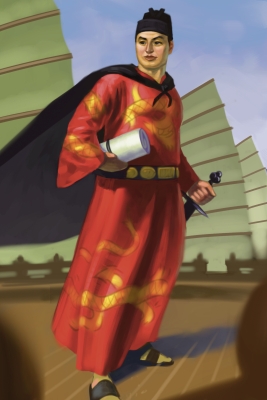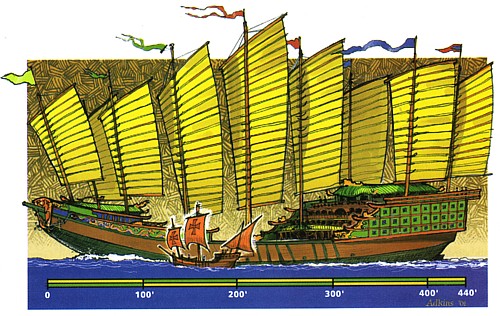
Zheng He (1371–1435), also known in English as Cheng Ho, with original Ma (surname), was a Hui-Chinese mariner, explorer, diplomat and fleet admiral, who commanded voyages to Southeast Asia, South Asia, the Middle East, and East Africa, collectively referred to as the "Voyages of Zheng He" or "Voyages of Cheng Ho" from 1405 to 1433. Zheng He also knew how to speak Arabic and Chinese.

The Grand Zheng He fleet
He was originally named 'Ma He' and was born in 1371. Zheng He was the second son of a Muslim family which also had four daughters, from Kunyang, present day Jinning, just south of Kunming near the southwest corner of Lake Dian in Yunnan.
He was the great great great grandson of Sayyid Ajjal Shams al-Din Omar, a Persian who served in the administration of the Mongolian Empire and was appointed governor of Yunnan during the early Yuan Dynasty. Both his grandfather and great-grandfather carried the title of Hajji, which indicates they had made the pilgrimage to Mecca. His great-grandfather was named Bayan and may have been a member of a Mongol garrison in Yunnan.
In 1381, the year his father was killed, following the defeat of the Northern Yuan, a Ming army was dispatched to Yunnan to put down the army of the Mongol Yuan loyalist Basalawarmi during the Ming conquest of Yunnan. Ma He, then only eleven years old, was captured by the Ming Muslim troops of Lan Yu and Fu Youde and made a eunuch. He was sent to the Imperial court, where he was called 'San Bao' meaning 'Three Jewels.' He eventually became a trusted adviser of the Yongle Emperor (r. 1403-1424), assisting him in deposing his predecessor, the Jianwen Emperor. In return for meritorious service, the eunuch received the name Zheng He from the Yongle Emperor.
In 1425 the Hongxi Emperor appointed him to be Defender of Nanjing. In 1428 the Xuande Emperor ordered him to complete the construction of the magnificent Buddhist nine-storied Da Baoen Temple in Nanjing, and in 1430 appointed him to lead the seventh and final expedition to the "Western Ocean". Zheng He died during the treasure fleet's last voyage, on the returning trip after the fleet reached Hormuz in 1433.
Voyages
1st Voyage (1405–1407) - Champa, Java, Palembang, Malacca, Aru, Sumatra, Lambri, Ceylon, Kollam, Cochin, Calicut
2nd Voyage (1407–1409) - Champa, Java, Siam, Cochin, Ceylon
3rd Voyage (1409–1411) - Champa, Java, Malacca, Sumatra, Ceylon, Quilon, Cochin, Calicut, Siam, Lambri, Kaya, Coimbatore, Puttanpur
4th Voyage (1413–1415) - Champa, Java, Palembang, Malacca, Sumatra, Ceylon, Cochin, Calicut, Kayal, Pahang, Kelantan, Aru, Lambri, Hormuz, Maldives, Mogadishu, Barawa, Malindi, Aden, Muscat, Dhufar
5th Voyage (1416–1419) - Champa, Pahang, Java, Malacca, Sumatra, Lambri, Ceylon, Sharwayn, Cochin, Calicut, Hormuz, Maldives, Mogadishu, Barawa, Malindi, Aden
6th Voyage (1421–1422) - Hormuz, East Africa, countries of the Arabian Peninsula
7th Voyage (1430–1433) - Champa, Java, Palembang, Malacca, Sumatra, Ceylon, Calicut, Hormuz (17 states in total)

The grand voyage of Admiral Cheng Ho with hundreds of fleet
According to the Malaysian history, Sultan Mansur Shah (ruled 1459–1477) dispatched Tun Perpatih Putih as his envoy to China and carried a letter from the Sultan to the Ming Emperor. Tun Perpatih succeeded in impressing the Emperor of Ming with the fame and grandeur of Sultan Mansur Shah.
In the year 1459, a princess Hang Li Po (or Hang Liu), was sent by the emperor of Ming to marry Malacca Sultan Mansur Shah (ruled 1459–1477). The princess came with her entourage 500 sons of ministers and a few hundred handmaidens. They eventually settled in Bukit Cina, Malacca. It is believed that a significant number of them married into the local populace. The descendants of these mixed marriages are locally known today as Peranakan and still use the honorifics Baba (male title) and Nyonya (female title).
In Malaysia today, many people believe it was Admiral Zheng He (died 1433) who sent princess Hang Li Po to Malacca in year 1459. However there is no record of Hang Li Po (or Hang Liu) in Ming annals. She is mentioned only within Malacca folklore and Malay annals.

Zheng He treasure fleet
Source: Wikipedia
In Melaka, there are two Cheng Ho museums were built by State Government of Melaka and private agency.
Cheng Ho Cultural Museum, Melaka

Historical records reveal that Ming Dynasty’s Admiral Cheng Ho (Zheng He) visited Melaka (Malacca) at least five times during his famous seven voyages to the Western Ocean (Southeast Asia, Indian Ocean, Middle East and Africa). He set up a huge warehouse complex along the northern side of the Melaka River. Thus far, there has been no serious investigation made on this fascinating topic. Some people claim that Zheng He’s warehouse was located in Bukit Cina because there is a Sampo (or San Bao referring to Cheng Ho) well and the area is named Sampo Hill. However, many others do not agree. The exact location of Cheng Ho’s warehouse is certainly worth serious study.
In 2000, attention was drawn to a cluster of dilapidated ancient buildings in the old part of Melaka town. At least three of them could have been built two or three hundred years ago. All of them have Ming architectural style. This discovery immediately rekindled interest on the mysterious location of the warehouse complex or Guang Chang mentioned in Ma Huan’s book Ying Yai Sheng Lan.
It is believed that the present Museum is situated on the original site of Guan Chang built by Cheng Ho, the Ming Grand eunuch, about 600 years ago. His mighty fleet of several hundred ships sailed seven times to the Western Ocean from China from 1405 to 1433.
Source: Cheng Ho Cultural Museum, Melaka
Admiral Cheng Ho Gallery
The Admiral Zheng He Gallery or the locals pronounce it Admiral Cheng Ho (Galeri Laksamana Cheng Ho) was open to the public in 2003.This gallery is inspired by the story of a Admiral Zheng He. The gallery displays many information about Zeng He voyage accross the South Sea and his achievement on Diplomatic success between Emperial China and Africa, South East Asia and open a trade-post between the Chinese and local merchant.
The gallery is located at the hill top of Stadhuys building to the right and between Literature Museum (Muzium Sastera), and Democratic Museum (Muzium Pemerintahan Demokrasi). It exhibit replica of Zheng He Ship, books and collections that tells Zheng He history, 500 years old porcelains and other artifacts related to Zheng He Voyages all over the world.
Source: Asmaliana.com

